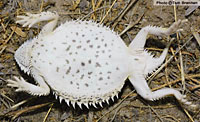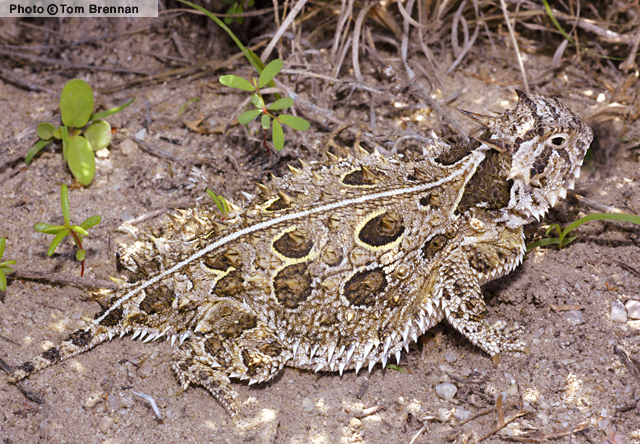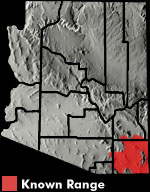Online Field Guide to The Reptiles and Amphibians of Arizona


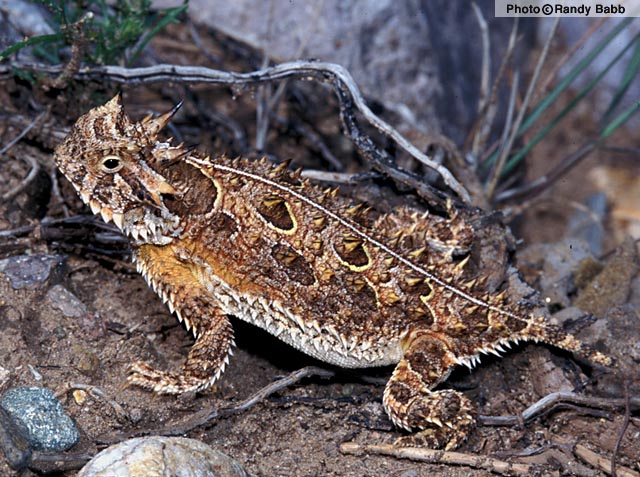
Cochise County, AZ
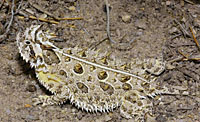 Cochise Co., AZ |
| TEXAS HORNED LIZARD Phrynosoma cornutum | |
|
DESCRIPTION: A medium-sized (up to 130 mm or 5″ from snout to vent), exceptionally flat and wide lizard with two long, horn-like scales projecting from the back of the head. Smaller horn-like scales protrude from the sides of the head and jaw. Several pointed, projecting scales are scattered across the back. There are large, keeled, spiny scales on the limbs, tail, and sides of throat. Each lower side of the body is edged with two fringes of enlarged, pointed scales. Each side of the tail is edged with a single fringe of enlarged, pointed scales. Base coloration is usually orange-brown, yellow brown, or gray. A distinct, crisp-edged, white or cream colored stripe runs down the middle of the back extending from the neck onto the base of the tail. Two or three wide, dark lines radiate from each eye distinguishing this lizard from all other horned lizards in Arizona. The back is marked with dark brown, circular blotches and there are two large, dark brown blotches on the neck. The rear edge of each neck and body blotch is outlined with a wide yellow-green, yellow, or cream colored line. The underside is plain white or cream. DISTRIBUTION: This lizard is distributed across the valleys of extreme southeastern Arizona. It occurs at elevations ranging from 3,000’ to about 6,000’. HABITAT: In our state the Texas Horned Lizard inhabits playas, low valleys, gentle bajadas, and foothills within Chihuahuan Desertscrub and Semidesert Grassland communities. It is usually found in relatively open areas with sandy or gravelly soil. BEHAVIOR: This diurnal ground-dweller spends nights sheltering in burrows or buried beneath the soil. It is often encountered basking and foraging in the morning sun. It seeks relief from the mid-day heat in the shade of plants and emerges again in the late afternoon to bask. It hibernates during the cold months of winter and late fall. When encountered it usually remains still and relying on its cryptic coloration to avoid detection. If crypsis fails it may sprint to the nearest shelter. It may squirt blood from its eyes when threatened or captured. This blood might have a foul taste designed to deter predators. Other defensive behaviors include inflating itself by gulping air and poking with the horns. The Texas Horned lizard has been observed to harvest rain by arching its back and lowering its head allowing rainwater to trickle down its body to the mouth. DIET: This lizard eats harvester ants and a variety of other insects including beetles and grasshoppers. It forages in the morning around the fringes of ant hills and along ant foraging columns. REPRODUCTION: Mating takes place in spring. One or more clutches of eggs are laid in spring and summer. Clutch size usually ranges from 13 to about 30 eggs but exceptionally large clutches can contain nearly 50 eggs. The eggs are laid in an underground nest chamber at the end of 6” to 8” tunnel. By Thomas C. Brennan
Brennan, T. C., & A. T. Holycross. 2005. A Field Guide to Amphibians and Reptiles of Maricopa County. Arizona Game and Fish Department. Phoenix, AZ Degenhardt, W. G., Painter, C. W., and Price, A. H.. 1996. Amphibians and Reptiles of New Mexico. University of New Mexico Press. Albuquerque. Stebbins, R.C. 2003. A Field Guide to Western Reptiles and Amphibians, Third Edition. Houghton Mifflin Company, Boston, MA. |
|
Visit Partners in Amphibian and Reptile Conservation:


HOME
Copyright © 2023, Arizona Game and Fish Department. All rights reserved.
If you make use of the textual contents of this site in reports, publications, etc. please cite and credit the author(s) and photographer(s). All photos on this website are copyrighted. However, those found in the species account section may be used for any noncommercial scientific, educational, or conservation purposes provided that photographs are not altered and continue to bear the copyright symbol and name of the photographer. Please contact the photographer regarding commercial use of copyrighted photographs.










